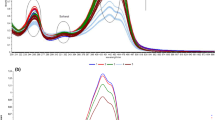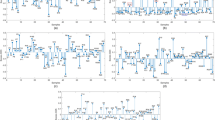Abstract
This work propose a feasible, rapid, and simple method for detecting culinary spices adulterated either with Sudan I dye or blends of Sudan I + IV dyes at three concentration levels. The method is based on the use of UV-visible spectroscopy with multivariate analysis. Four types of spices were studied: three paprika varieties (mild, hot, and smoked) and a spice commonly consumed in Argentina called aji molido. Principal components analysis was firstly applied as an exploratory analysis and then, two classification techniques were used: K-nearest neighbors (KNN) and partial least squares-discriminant analysis (PLS-DA). Three classes were defined: unadulterated samples and adulterated samples with Sudan I or blends of Sudan I + IV dyes at 1, 2.5, and 5 ppm (mg L−1). Classification techniques gave satisfactory results: between 89 and 100 % for PLS-DA and between 83 and 92 % for KNN. The sensitivity and specificity of the models were above 83 %. It has to be highlighted that none of the adulterated samples were assigned as unadulterated, which is very positive because of the implication that these results have on consumer health. The capability of detecting mixtures of Sudan dyes is a very important advantage because each Sudan dye generates different hazardous metabolites in human body so their toxicity may be enhanced by the simultaneous presence of such dyes.






Similar content being viewed by others
References
Almeida MR, Oliveira KS, Stephani R, de Oliveira FLC (2011) J Raman Spectrosc 42:1548–1552
Anfossi L, Baggiani C, Giovannoli C, Giraudi G (2009) Food Addit Contam Part A 26:800–807
ASTA (2005) American spice Trade Association. <http://www.astaspice.org/files/public/SudanWhitePaper.pdf>
Bakeev KA (2010) Process analytical technology, 2nd edn. Wiley, Chichester
Chen L, Xue X, Ye Z, Zhou J, Chen F, Zhao J (2011) Food Chem 128:1110–1114
Cheuung W, Shadi IT, Xu Y, Goodacre R (2010) J Phys Chem C 114:7285–7290
Commission Decision 669/2009/EC of July 2009 (2009) Off J Eur Commun L194:11–21
Della Donna L, Ronci M, Sacchetta P, Di Ilio C, Biolatti B, Federici G, Nebbia C, Urbani A (2009) Biotechnol J 4:1596–1609
Di Anibal CV, Odena M, Ruisánchez I, Callao MP (2009) Talanta 79:887–892
Di Anibal CV, Ruisánchez I, Callao MP (2011) Food Chem 12:1139–1145
Di Anibal CV, Marsal LF, Callao MP, Ruisánchez I (2012) Spectrochim Acta Part A 87:135–141
Fonovich T (2013) Drug Chem Toxicol 36:343–352
Hou X, Li Y, Wu G, Wang L, Hong M, Wu Y (2010) J Chromatogr Sci 48:22–25
IARC (International Agency for Research on Cancer) (1975) Lyon. IARC monographs on the evaluation of the carcinogenic risk of chemicals to man: some aromatic azo compounds 8:224–231
Johnson GE, Quick EL, Parry EM, Parr JM (2010) Mutagenesis 25:327–333
Liu J, Zhang H, Zhang D, Gao F, Wang J (2012) Anal Biochem 423:246–252
Meza-Márquez OG, Gallardo-Velázquez T, Osorio-Revilla G (2010) Meat Sci 86:511–519
Mishra KK, Dixit S, Purshottam SK, Pandey RC, Das M, Khanna SK (2007) Int J Food Sci Technol 42:1363–1366
Oliveri P, Baldo MA, Daniele S, Forina M (2009) Anal Bioanal Chem 395:1135–1143
Qiao J, Yan H, Wang H, Wu Y, Pan P, Geng Y (2011) Chromatographia 73:227–233
RASFF (2005) Rapid Alert System for Food and Feed, Annual Report. http://ec.europa.eu/food/food/rapidalert/report2005_en.pdf. Accessed 03.13
RASFF (2006) Rapid Alert System for Food and Feed, Annual Report. http://ec.europa.eu/food/food/rapidalert/report2006_en.pdf. Accessed 03.13
RASFF (2008) Rapid Alert System for Food and Feed, Annual Report. http://ec.europa.eu/food/food/rapidalert/report2008_en.pdf. Accessed 03.13
Rebane R, Leito I, Yurchenko S, Herodes K (2010) J Chromatogr A 1217:2747–2757
Stivorová M, Martínek V, Semanská M, Hodek P, Dracínský M, Cvacka J, Schmeiser HH, Frei E (2009) Interdisc Toxicol 2:195–200
Tripathi M, Khanna SK, Das M (2007) Food Control 18:211–219
Xiao F, Zhang N, Gu H, Qian M, Bai J, Zhang W, Jin L (2011) Talanta 84:204–211
Xu H, Heinze TM, Chen S, Cerniglia CE, Chen H (2007) Appl Environ Microbiol 73:7759–7762
Xu H, Heinze TM, Paine DD, Cerniglia CE, Chen H (2010) Anaerobe 16:114–119
Yan H, Qiao J, Pei Y, Long T, Ding W, Xie K (2012) Food Chem 132:649–654
Yuan J, Liao L, Lin Y, Deng C, He B (2008) Anal Chim Acta 607:160–167
Yuan W, Xiang B, Yu L, Xu J (2011) Food Anal Methods 4:550–558
Acknowledgments
Financial support from the Consejo Nacional de Investigaciones Científicas y Tecnológicas (CONICET), the SeCyT-Universidad Nacional del Sur, and the FIA Laboratory of the Analytical Department (INQUISUR-UNS) are gratefully acknowledged.
Conflict of Interest
Carolina Di Anibal declares that she has no conflict of interest. Maria Susana Rodriguez declares that she has no conflict of interest. Liliana Albertengo declares that she has no conflict of interest. This article does not contain any studies with human or animal subjects.
Author information
Authors and Affiliations
Corresponding author
Rights and permissions
About this article
Cite this article
Di Anibal, C., Rodriguez, M.S. & Albertengo, L. UV-Visible Spectroscopy and Multivariate Classification as a Screening Tool to Identify Adulteration of Culinary Spices with Sudan I and Blends of Sudan I + IV Dyes. Food Anal. Methods 7, 1090–1096 (2014). https://doi.org/10.1007/s12161-013-9717-2
Received:
Accepted:
Published:
Issue Date:
DOI: https://doi.org/10.1007/s12161-013-9717-2




